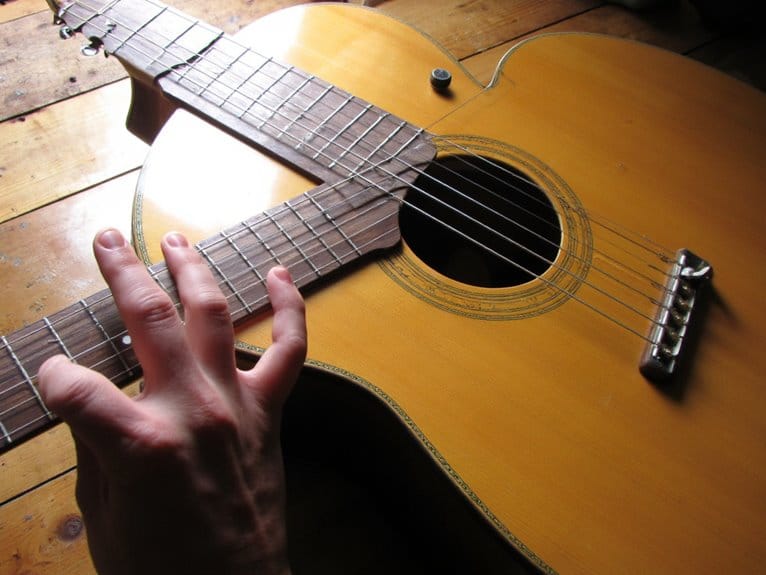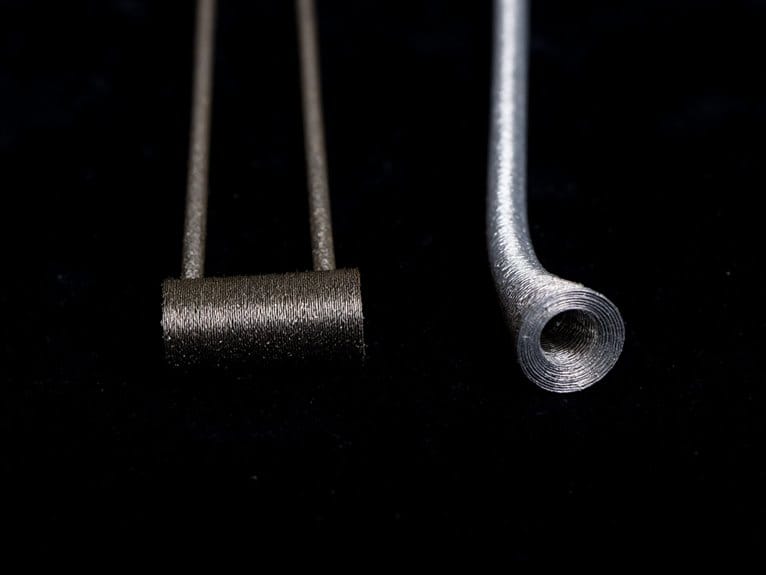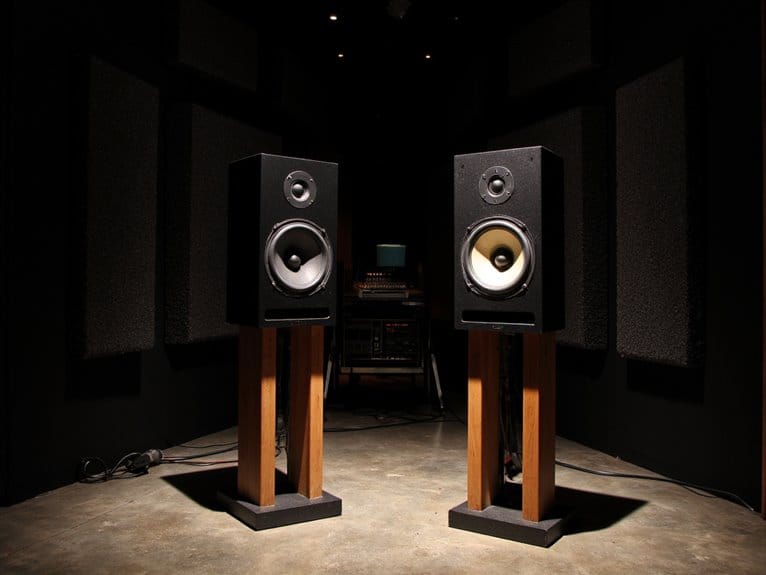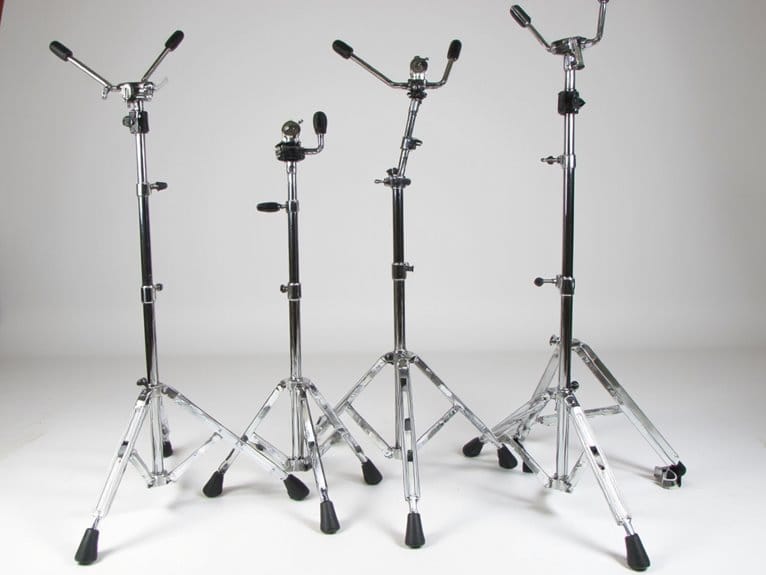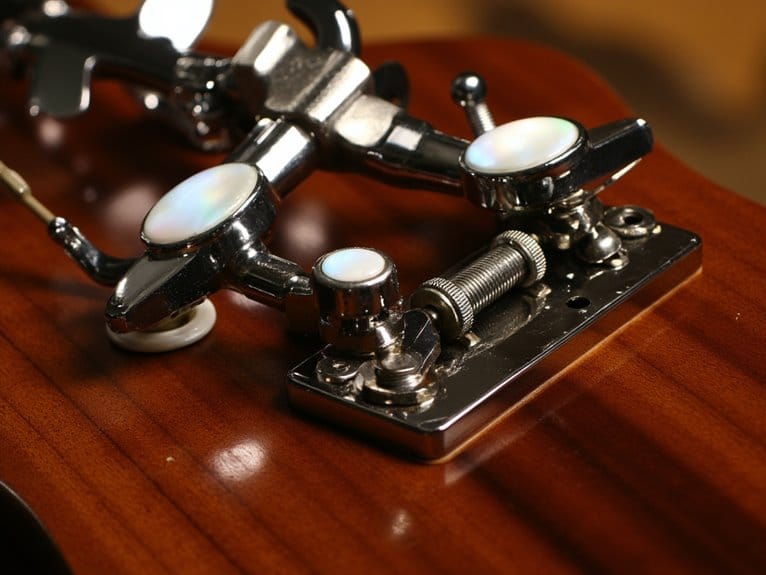Understanding Guitar Scales and Their Applications
Guitar scales serve as your roadmap across the fretboard, transforming random notes into purposeful musical expression through structured interval patterns like the major scale’s whole-whole-half sequence and minor pentatonic‘s blues-driven simplicity. You’ll find the CAGED system connects five chord shapes (C-A-G-E-D) into thorough fretboard navigation, while genre-specific applications range from jazz’s sophisticated Dorian modes to rock’s powerful minor pentatonic foundations. Master these fundamentals through consistent practice at 60 bpm, and you’ll access deeper musical possibilities that await exploration.
We are supported by our audience. When you purchase through links on our site, we may earn an affiliate commission, at no extra cost for you. Learn more.
Notable Insights
- Master five fundamental scale types: major (bright/happy), natural minor (melancholic), harmonic minor (exotic), melodic minor (bridging), and modes.
- Use the CAGED system’s five chord shapes (C-A-G-E-D) to navigate the fretboard and connect scale patterns across positions.
- Apply genre-specific scales: pentatonic for rock/blues, Dorian/Lydian for jazz, and natural minor for metal improvisation and solos.
- Build scales using interval patterns like whole-whole-half-whole-whole-whole-half for major scales and understand how intervals create emotional qualities.
- Practice effectively by starting at 60 bpm, visualizing patterns before playing, and incorporating varied rhythmic exercises for musical expression.
Fundamental Scale Types and Their Musical Characteristics
When I first started exploring guitar scales years ago, I quickly discovered that understanding the five fundamental scale types—major, natural minor, harmonic minor, melodic minor, and the various modes—forms the backbone of virtually every musical style you’ll encounter on the instrument.
The major scale‘s bright, happy character contrasts sharply with the natural minor’s melancholic tone, creating essential tonal contrast that defines most Western music.
Through scale evolution, you’ll find that harmonic minor adds exotic tension with its raised seventh degree, while melodic minor bridges major and minor sounds seamlessly. The chromatic scale consists of all twelve notes in an octave, serving as a complete musical alphabet that guitarists can use for finger coordination exercises and warm-up routines.
The pentatonic scales offer a simpler starting point with only five notes each, making them particularly accessible for beginners while remaining essential for creating famous rock riffs and melodies.
Modes like Dorian and Phrygian expand your palette further, each offering distinct interval structures that reveal unique harmonic possibilities, though I’ll admit Locrian’s diminished fifth still challenges me occasionally.
The CAGED system transforms your fretboard navigation by connecting five essential chord shapes—C, A, G, E, and D—into a thorough mapping system that’ll release every corner of your guitar’s neck.
You’ll discover that each shape contains specific scale patterns and modal connections, creating a framework where the same chord can be played in multiple positions while maintaining consistent fingering relationships. The system breaks the neck into five sections for visual connection, making it easier to understand how different areas of the fretboard relate to each other.
Once you grasp how these shapes link together in sequence, moving from one position to another becomes intuitive, and you’ll start recognizing the modal characteristics that emerge naturally within each CAGED pattern.
Five Essential Shape Patterns
Five interconnected shape patterns form the backbone of the CAGED system, a method I’ve found invaluable for understanding how chords and scales connect across the entire fretboard. Each pattern offers unique fingerboard geography, creating seamless shape variations that reveal different tonal regions.
| Pattern | Key Characteristic |
|---|---|
| C Shape | Rounded fingering for lower mid-neck |
| A Shape | Three-finger cluster formation |
| G Shape | Wide span with complexity |
| E Shape | Barre chord foundation |
The C shape provides rounded fingering in lower positions, while A shape acts as your bridge between sections. G shape challenges you with its wide span, E shape delivers that fundamental barre chord strength, and D shape completes the cycle with compact efficiency. These scale shifts create fluid movement across all fretboard areas, transforming isolated chord knowledge into thorough neck navigation.
Modal Connections Within CAGED
Seven distinct modes emerge naturally when you apply the CAGED system to modal scales, creating a framework that alters abstract music theory into tangible fretboard positions.
Each shape becomes a gateway to specific modal sounds, where tonal centers align perfectly with your familiar chord forms, making scale shifts feel intuitive rather than academic.
The modal flow between adjacent CAGED shapes reveals characteristic intervals that define each mode’s unique personality.
Your improvisation strategies expand dramatically when you recognize these shape relationships, as harmonic integration becomes second nature through targeted modal exercises.
- C Shape + Ionian Mode: Major scale foundation with root positioning for bright, resolved sounds
- A Shape + Dorian Mode: Minor tonality with natural 6th creating sophisticated jazz flavors
- G Shape + Phrygian Mode: Exotic Spanish-influenced tones through the distinctive b2 interval
- E Shape + Lydian Mode: Dreamy, floating quality from the raised 4th degree
- D Shape + Mixolydian Mode: Dominant character perfect for blues and rock melodic extension
This fretboard mapping system transforms modal theory into practical playing knowledge.
Genre-Specific Scale Applications in Guitar Playing
Now that you’ve mastered the CAGED system for traversing the fretboard, you’re ready to explore how different musical genres utilize specific scales to create their distinctive sounds and emotional impact.
Blues and rock music form the backbone of modern guitar playing, relying heavily on minor pentatonic and natural minor scales to generate those soulful bends, aggressive power chord progressions, and memorable solos that define these influential genres. Whether you’re playing clean passages or driving your amp into saturation, boost pedals can enhance the clarity and volume of your scale work, making every note cut through the mix with precision.
Jazz takes a completely different approach, embracing modal applications like Dorian and Lydian scales, which provide sophisticated harmonic frameworks that allow you to maneuver through complex chord changes while creating those smooth, intellectually satisfying improvisations that separate jazz from simpler musical forms.
For extreme metal styles, scales must maintain clarity even at high gain settings, where complex chord progressions and rapid note sequences can easily become muddy without proper tonal control.
Just as pickup selection influences your guitar’s tonal character across genres, choosing the right pickup magnets like Alnico II for warmer blues tones or ceramic magnets for focused heavy metal sounds will enhance your scale work and help you achieve the authentic voice your musical style demands.
Blues and Rock Essentials
When you’re diving into blues and rock guitar, the blues scale becomes your most reliable companion, offering a foundation that’s shaped countless legendary solos and riffs across decades of musical evolution.
The minor blues scale, built from the pentatonic with that essential diminished fifth “blue note,” creates the tension and release that defines authentic blues improvisation techniques. You’ll find yourself switching between major and minor blues scales over dominant chords, which dramatically affects your rock guitar phrasing’s emotional impact.
- Master E-shaped and A-shaped patterns for comfortable fretboard navigation and position flexibility
- Practice bending and vibrato on blue notes to develop authentic blues expression and feel
- Use backing tracks in common keys like A, E, and D for practical application
- Mix major and minor blues scales to create dynamic contrast in your solos
- Start with minor blues over tonic chords before exploring more complex applications
Many guitarists find that developing scale proficiency on bass guitar helps strengthen their understanding of rhythm section dynamics and low-end frequencies that support the harmonic foundation of blues and rock music.
Jazz Modal Applications
As you shift from the blues scale’s familiar patterns into jazz territory, modal scales become your gateway to sophisticated harmonic expression, offering seven distinct colors that transform how you approach chord progressions and improvisation.
Modal theory fundamentally changes chord function perception, where Dorian mode over ii chords, Mixolydian over V chords, and Ionian over I chords creates the classic ii-V-I progression framework.
These improvisational techniques rely on understanding scale degrees and their relationship to underlying harmony, with characteristic tones like Lydian’s raised fourth or Dorian’s natural sixth providing harmonic color.
Modal shifts within jazz progressions introduce tension release dynamics while maintaining melodic coherence, allowing you to emphasize chord tones that align with each mode’s distinctive intervallic structure for sophisticated harmonic expression.
Scale Construction Through Interval Patterns
Understanding how scales work on guitar becomes dramatically easier once you grasp the underlying interval patterns that serve as their architectural blueprints.
These patterns act as mathematical formulas, where whole steps (two frets) and half steps (one fret) create distinct sonic characteristics that define each scale’s personality.
- Major scale pattern: w-w-h-w-w-w-h creates the familiar “do-re-mi” sound we’ve heard since childhood
- Natural minor pattern: w-h-w-w-h-w-w produces the melancholic, emotional quality found in countless ballads
- Harmonic minor modification: Raising the 7th degree creates that mysterious, exotic sound favored in classical compositions
- Perfect intervals (4ths and 5ths): Form the backbone of power chords, providing harmonic stability across genres
- Third intervals: Determine major versus minor chord quality, with major thirds sounding “happy” and minor thirds “sad”
Through interval recognition and scale modification, you’ll reveal the fretboard’s geometric patterns, transforming complex theory into practical, moveable shapes.
Effective Practice Methods and Technical Development
Although mastering interval patterns provides the theoretical foundation, developing the physical technique to execute scales fluently requires a systematic approach that I’ve refined through years of teaching students who initially struggled with coordination and timing.
Your journey toward technical flexibility begins with effective warming routines at 60 bpm, focusing on finger dexterity through progressive exercises that combine picking techniques with legato passages.
Mental preparation involves visualizing patterns before playing, which dramatically improves practice efficiency and muscle memory development.
I’ve found that pressure management—keeping fingers just behind frets with minimal force—prevents fatigue while maintaining clean articulation. Many guitarists benefit from zero-latency monitoring when practicing with headphones, as this prevents the timing delays that can disrupt your natural rhythm development.
Incorporating varied rhythmic control exercises prevents mechanical playing, while coordinating alternate picking with hammer-ons develops the foundation for truly expressive playing that separates competent players from exceptional ones.
Recording your practice sessions through an affordable audio interface can provide valuable feedback on timing inconsistencies and tonal quality that are often missed during live performance. Professional interfaces with 24-bit/192kHz resolution capture the subtle nuances of your guitar tone, allowing you to identify areas where your technique needs refinement.
Scale Classification and Perceptual Impact
When I first started categorizing scales for my students, I quickly discovered that organizing them by structural characteristics—note count, tonal function, and fretboard positioning—creates a logical framework that transforms what seems like an overwhelming collection of patterns into manageable, interconnected systems.
Scale perception directly influences emotional response, with pentatonic scales offering melodic simplicity that enhances listener engagement while exotic scales introduce cultural influences and unique tonal color. Your choice between major scales’ bright resolution and minor pentatonic’s soulful character determines the musical tension you’ll create, affecting how audiences interpret your improvisational freedom. Understanding these tonal relationships becomes especially valuable when translating scale knowledge to bass guitar, where dual pickups provide the versatility to explore different scale applications across various musical genres. Just as directional microphones require optimal positioning within 3-6 feet for effective recording, musical scales demand proper fret positioning to maximize their expressive impact. When recording guitar scales, a microphone with cardioid pattern helps isolate your instrument from ambient noise while capturing the full tonal character of each scale application.
- Major scales evoke happiness through balanced interval structures
- Minor pentatonic conveys blues emotion via flattened thirds and sevenths
- Exotic scales create mystery using altered intervals like flat seconds
- Pentatonic simplicity produces memorable, catchy melodic lines
- Chromatic alterations generate complex, jazzy perceptual qualities
Frequently Asked Questions
How Do I Choose Which Scale to Use Over Complex Jazz Chord Progressions?
For scale selection over complex jazz progressions, you’ll identify each chord’s parent scale first, then analyze chord tones and alterations. Choose modes from major, harmonic minor, or melodic minor scales that accommodate the chord’s tensions and function.
Can I Mix Different Scales Together While Improvising or Does It Sound Bad?
You can absolutely mix scales during improvisation! Scale blending sounds great when you understand chord relationships and practice smooth shifts. These improvisation techniques create musical interest, but require fretboard knowledge to avoid clashing with underlying harmonies.
What’s the Difference Between Relative and Parallel Minor Scales in Practical Playing?
Relative minor uses the same notes as your major scale but shifts the tonal center three frets down. Parallel minor keeps the same root but flattens the third, sixth, and seventh degrees for darker harmonic colors.
On a final note
You’ve now got the essential framework for understanding guitar scales, from basic construction patterns to advanced fretboard navigation techniques. While I can’t promise you’ll master these concepts overnight, consistent practice with the CAGED system and genre-specific applications will dramatically improve your playing versatility. Remember, scales aren’t just academic exercises—they’re your roadmap to musical expression and creative freedom on the instrument.

